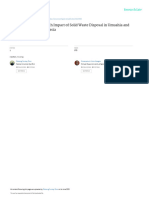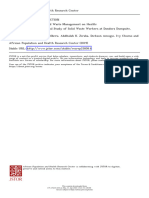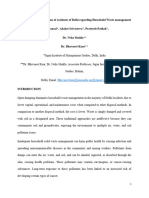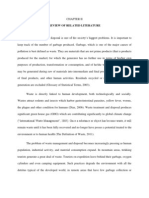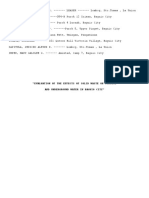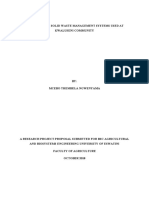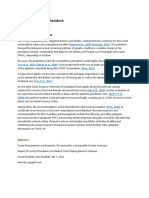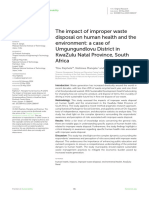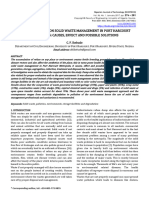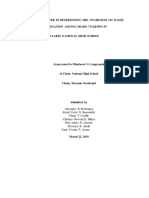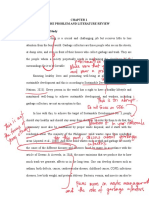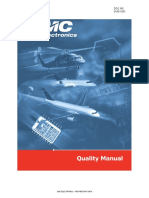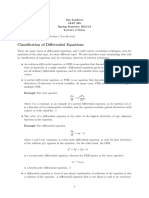Waste Topic Two
Waste Topic Two
Uploaded by
Jusu SovilaCopyright:
Available Formats
Waste Topic Two
Waste Topic Two
Uploaded by
Jusu SovilaCopyright
Available Formats
Share this document
Did you find this document useful?
Is this content inappropriate?
Copyright:
Available Formats
Waste Topic Two
Waste Topic Two
Uploaded by
Jusu SovilaCopyright:
Available Formats
International Journal of Research in Business Studies and Management
Volume 6, Issue 7, 2019, PP 14-22
ISSN 2394-5923 (Print) & ISSN 2394-5931 (Online)
Environmental and Socio-Economic Effect of Solid Waste on
Local Livelihood in: Sierra Leone. A Case Study of Freetown
Municipality
Samuel Mansaray-Pearce*
Resources and Environmental Economics Huazhong University of Science and Technology, China
*Corresponding Author: Samuel Mansaray-Pearce, Resources and Environmental Economics
Huazhong University of Science and Technology, China, Email: mansaraysamuel192@gmail.com
ABSTRACT
This paper investigates the environmental and socio-economic effects of solid waste generated activities on
the livelihood of the local people in Freetown, Sierra Leone. In addition to the sampling community opinions
of waste generated activities, the paper recommends participation that can help in solid waste management
in order to mitigate its negative effects. Obvious environmental and socio-economic enhancement can be
realized within waste disposal communities if the government provides the required financial and technical
support to community members together with the ability and willingness to recycle municipal solid waste.
Keywords: Local people, Solid waste, Socio-economic, Freetown municipality
INTRODUCTION M.Aatamila, et al., 2010). The conclusion from
these and other works has contributed to an
Open garbage dumpsite method as solid waste
increasing curiosity of academics in the study
disposal scheme is a primeval stage of solid linking to environmental effluence as well as its
waste supervision in many parts across the
consequences on human income and biodiversity.
globe. It is one of the extreme inadequately Very few of these researchers studied the
condensed services by community stakeholders environmental and socio-economic insinuations
in emerging nations as the methods applied are of solid waste disposal to individuals living in
unscientific, archaic and ineffective. Open
areas close to wastes dumpsites (K. O. Boardi
garbage dumpsites are found both within and on and M. Kuitunen, 2005; A. B. Nabegu, 2010).
the peripheries of emerging urban capitals. With The growing consumption of goods results in
upsurge in the global populace and the mounting enormous amounts of solid wastes from work
demand for goods and other fundamentals, there and domestic actions, which pose substantial
has been intensification in the volume of waste threats to human health (R. A. Frosch, 1996).
being produced daily by each family. This However, the harms of inappropriately disposed
excess is eventually thrown into community
municipal solid wastes are quite abundant to be
dumping sites and due to poor and unsuccessful pointed out. Health hazard, disaster, overflow
management, the garbage sites turn to bases of incidences, and environmental pollution are just
environmental and health threats to those living a few of the negative impacts. In many
in the locality of such landfills. unindustrialized countries, solid waste dumping
One of the key aspects of anxiety is the sites are located on the fringes of metropolitan
pollution produced to the terrain—be it air, areas. These regions develop teens‟ sources of
water and land. As stated by Nguyen et al. infection due to the generation and spread of
(2011) several cities in unindustrialized nations flies, mosquitoes, and rodents. These are disease
encounter grave environmental untidiness and transmitters that distress the health of the
health menacesdue to the feebly industrialized populace. The supposed condition produces
urban solid waste management scheme. malaria, cholera, breathing, genetic, and
Numerous researches have been carried out in numerous other kind of communicable diseases
order to scrutinize the health and ecological (A. Salam, 2010). Open landfills in
effects mounting from waste landfills. Such unindustrialized municipal cities involve
findings disclosed that a relationship exists haphazard disposal of waste. They are not
between the two (H. B. N. Yongsi, et al., 2008; controlled and consequently pose key health
International Journal of Research in Business Studies and Management V6 ● I7 ● 2019 14
Environmental and Socio-Economic Effect of Solid Waste on Local Livelihood in: Sierra Leone. A Case
Study of Freetown Municipality
threats which affect the environs of urban not directly transported from land to individuals,
municipalities (D. Sood, 2004). The UNEPA except in the circumstance of dusts and through
(2006) stated that wastes that are not contact with toxic constituents. Chemicals
appropriately managed, particularly solid waste dumped on land typically enter the human
from families and the community, are a crucial system through the form of polluted vegetables,
health risk and lead to the spread of infectious animals, food products, or water. These
diseases. The report additionally acknowledged surroundings are inferior in the summer because
that unattended wastes plying around entice of thrilling temperatures, which speed up the
flies, mosquitoes, cockroaches, rats and other frequency of microbial action on decomposable
creature that turn out to spread diseases. organic solid. Dumping spots can also generate
Normally, it is the drizzly waste that decays and health hazards for the locality (K. O. Boardi and
releases a bad stench. The bad stench impacts M. Kuitunen, 2005). Gouveia and Ruscitto
the people settled next to the trash pile, which (2009) emphasized that in a number of health
shows that the dumpsites have serious effects to studies, a wide range of health issues, including
people settled around or next to them. The irritation of the skin, nose and eyes, respiratory
people at risk from this repulsive disposal of systems, intestinal glitches, mental illnesses, and
waste includes-the people in neighborhood anaphylaxis, have been revealed. Also, landfills
where there is no appropriate waste disposal closer to residential areas are continuously
scheme, particularly the preschool children, feeding homes for domestic animals such as cats
waste staffs and employees in facilities and dogs. These animals, together with rodents,
manufacturing toxic and infectious resources. transmit diseases with them to neighboring
Other high-risk set includes people staying close homesteads. Sierra Leone is one of the deprived
to the waste dump (M. Aatamila, et al., 2010). countries in the universe, facing one of the worst
In particular, carbon-based domestic waste solid waste administration challenges and
poses a great hazard, since they instigate, remains a constant concern for both indigenous
forming situations favorable to the existence and and Global agencies. The problem of waste
development of microbial pathogens. Direct management, tied with scarce economic
management of solid waste can result in resources, has led to unselective disposing of
numerous types of communicable and lingering solid waste into open places and drainages,
diseases with the waste employees and rag blocking pipes and causing overflowing,
pickers being the utmost at risk (J. A. Nwanta environment contamination and municipal
and E. Ezenduka, 2010). Studies led by Yongsi health problems (UNEP, 2013; Perera, 2003). In
(2008) display that subjection to harmful waste Sierra Leone, the problem of poor solid waste
in landfill can affect human health, kids being supervision in Freetown is exacerbated by rapid
the most susceptible to these contaminants. population expansion and continuous economic
Direct contact can result to infections through development; waste generation in residential as
biochemical subjection as the release of toxic well as business areas remains to grow quickly,
waste into the environs leads to chemical pushing pressure on community's ability to
extermination. Rushton (2003) in his research to process and discard of these resources. This has
ascertain a link between health and harmful positioned a massive pecuniary load on local
substance revealed that biochemical from administration, making it tough for them to
agriculture and manufacturing can also lead to achieve solid waste sustainably (Crook and
serious health hazards. On the other hand, co- Ayee, 2006; Oteng-Ababio, 2010). Also,
disposal of industrial waste with municipal improper waste handling in accord with
waste can subject people to toxic and unrestrained waste discarding can root a
radioactive hazards. Health care excess and comprehensive range of glitches, including
other medical unused disposed in landfill, mixed contaminating water, enticing rodents and bugs,
with domestic refuse, increasing the menace of as well as increasing overflows due to blockage
contamination with Hepatitis B and HIV, and in pipes. Improper solid waste supervision can
other associated diseases (World Bank, 2005). as well upsurge greenhouse gas (GHG) release,
Open land fillis a key problem to the hence contributing to climate change (M.
atmosphere particularly to the air that we gasp. Aatamila, et al., 2010). Besides the ancient and
Open landfills release horrible smells that fairly well-structured neighborhoods of the
causes infection to those living close to them (E. center of Bangui, the entire of the capital (more
Marshal, 1995). According to Medina (2002), than 80% of the urbanized space) has the
effluence, a key ecological effect of landfills, is following characteristics: high density and risky
15 International Journal of Research in Business Studies and Management V6 ● I7 ● 2019
Environmental and Socio-Economic Effect of Solid Waste on Local Livelihood in: Sierra Leone. A Case
Study of Freetown Municipality
living situations of the inhabitants, insalubrity localities (Dominguez-Torres et. al., 2012). It
and under- equipment (drainage networks, has a total estimated land size of 71,740 sq.km),
roads, urban equipment and services, water, geographically lies between latitude 4°22′N and
electricity). In the different neighborhoods this 18°35′E and longitudes 7° 0' 0" N and 21° 0' 0"
situation can be aggravated to the topography E and located within the mountainous woodland
which directly determines the exposure to floods Region of the country.
and waste transported by rainwater (Nguimalet,
Data Collection and Analysis
2007). In some municipalities, the overflow of
runoff exposes sites susceptible to immense A direct face-to-face interview was employed in
floods requiring protective works. The main this study to elicit information by using a
capital is one of the most affected town halls combination of methods, including participatory
because it is located in the lower chunk of the rural appraisal (PRA) tools and techniques,
city and receives a lot of runoff from the hills, participant observations, and formal and
crossing the city. informal surveys. Pair-wise ranking was initially
carried out to help identify harms caused by
This paper therefore sought to present findings
solid waste disposal as acknowledged by the
of a study carried out in Freetown municipal
local people in the research area, and to rank
area in Sierra Leone to determine the
socio-economic activities based upon their
environmental and socio-economic influence of
contribution to household livelihood. The
solid waste dumping on local livelihood.
discussion made use of frequencies, percentages
We suggested new insights concerning the and means. Analysis of variance (ANOVA) and
dumpsite in conjunction to reducing the high cross tabulations involving chi-square tests were
prevalent rate of air and water borne diseases used to test statistical discrepancies in various
and other waste generated infections in the indicators between solid waste disposal and
municipality. The results obtainable could be of non-solid waste disposal communities.
significance for many urban communities in
emerging countries and researchers interested in RESULTS AND DISCUSSION
waste management. Socio-Economic Characteristics of the
In a case study of the Freetown Municipality, Respondents
the current study wanted to examine the extent Table 1details the percentage of the respondents
of Sierra Leone solid waste environmental and interviewed during the survey. There was no
socio-economic impacts. The specific objectives significant difference in gender within surveyed
of the research are as follows: waste disposal and non-waste disposal
communities (p > 0.05). Only 28.4% of the
To categorize and evaluate socio-economic
respondents in solid waste disposal areas were
activities which are significantly influenced
males (Table 2), likely because solid waste
by solid waste activities.
disposal activities are gender and age-oriented,
To evaluate local communities observations demanding the services of more females and
on how solid waste activities impact the young children (age bracket < 18) than males
environment. (particularly adults).
To proffer solid policy recommendations that Solid waste disposal and non-solid waste
can help in mitigating the harmful impacts of disposal communities exhibited minimal
solid waste. difference in terms of average household size:
On average, household size was 5.4 and 5.7
Study Area persons per household within the surveyed
The study was conducted in Freetown the main waste disposal and non-waste disposal
capital of Sierra Leone, Freetown metropolis communities respectively (Appendix 1).
was selected for the study because of rapid Surveyed areas likely have comparatively higher
urbanization and expansion of the metropolis household sizes because of the existence of the
which has led to enormous increase in solid commercial and or industrial activities, which
waste generation (Dominguez-Torres, Carolina; generate population increase through migration.
Foster, Vivien. 2012). According to the 2012 The characterization survey found that all types
Population and Housing Census (PHC), it had of waste are produced by a large majority of the
an estimated population of 1.2 million people, population surveyed in the waste disposal
with a higher proportion (43.6%) living in urban communities (Appendix 3). The composition of
International Journal of Research in Business Studies and Management V6 ● I7 ● 2019 16
Environmental and Socio-Economic Effect of Solid Waste on Local Livelihood in: Sierra Leone. A Case
Study of Freetown Municipality
waste is marked by the high production of incombustibles (pebbles, stone ...) are also
agricultural waste (31%) and organic waste found in household waste with a fairly
(25%). The fine elements (sieving 10 mm) and significant fraction (11%).
Table1. Socio-economic characteristic of respondents in this survey
Variable Community status Total χ2 –Value
Waste disposal community Non-waste disposal community (n=172)
(n=86) (n=86)
Gender 0.275ns
Male 17 (19.8) 24 (27.9) 41 (23.8)
Female 69 (80.2) 62 (72.1) 131 (76.2)
Household size 0.703ns
1-4 11 (12.8) 13 (15.1) 24 (14.0)
5-7 32 (37.2) 30 (34.9) 62 (36.0)
8-10 28 (32.6) 26 (30.2) 54 (31.4)
>10 15 (17.4) 17 (19.8) 32 (18.6)
Source: Field survey (2017).
Figures out of parentheses are frequencies and ns = Non-significant at P > 0.05.
those in parentheses are percentages
Table2. Characteristics of waste depositors interviewed
Variable Community status Total χ2 –Value
Waste disposal community Non-waste disposal community (n=110)
(n=95) (n=15)
Gender 0.041*
Male 27 (28.4) ….. 27 (24.5)
Female 68 (71.5) 15 (100.0) 83 (75.5)
Age category 0.038*
<18 25 (26.3) 5(33.3) 30 (27.2)
18-30 6 (6.3) ….. 6 (5.5)
31-43 19 (20.0) 3 (20.0) 22 (20.0)
44-56 32 (33.7) 7 (46.7) 39 (35.5)
>56 13 (13.7) …. 13 (11.8)
Source: Field survey (2017).
Figures out of parentheses are frequencies and diverse economic activities, including trading
those in parentheses are percentages (petty trading), Agricultural activities,
*Significant at p<0.05. Within the surveyed construction works and civil service activities
area, respondents reported to be involved in etc. (Table 3).
Table3. Socio-economic activities of the respondents
Variable Community status Total χ2 –Value
Waste disposal community Non-waste disposal community (n=172)
(n=86) (n=86)
Main occupation
Trading 38 (44.2) 62 (72.1) 100 (58.1) 0.014*
Agriculture 27 (31.3) …. 27 (15.7) 0.000***
Civil service 6 (7.0) 10 (11.6) 16 (9.3) 0.721ns
Construction 3 (3.5) …. 3 (1.7) ……
works
Driving 4 (4.7) 9 (10.5) 13 (7.6) 0.035*
Saloon …. 2 (2.3) 2 (1.2)
Unemployed 5 (5.8) …. 5 (2.9)
Retired …. 3 (3.5) 3 (1.7)
Others 3 (3.5) …. 3 (1.7)
Some 31.3% of respondents in solid waste Large proportions of respondents (44.2% and
disposal communities reported to be engaged in 72.1% solid waste disposal and non-solid waste
agricultural activities as a primary occupation. disposal communities, respectively) were
17 International Journal of Research in Business Studies and Management V6 ● I7 ● 2019
Environmental and Socio-Economic Effect of Solid Waste on Local Livelihood in: Sierra Leone. A Case
Study of Freetown Municipality
engaged in trading activities. It was indicated in solid waste disposal communities, findings
that poor waste management are the main reason which suggest that solid waste activities have a
behind unpredictable disease outbreak, due to negative socio-cultural impact on the livelihoods
the fact that many locals have chosen to take up of the local people.
petty trading and agriculture as an occupation.
Table4. Pair-Wise Ranking of Socio-Economic
Excessive garbage disposal, which are
Activities in Waste Disposal Community
commonly associated with high risks and
destruction, are as a result of poor management Socio-economic 1 2 3 4 5 6 7 Rank
in the waste that are largely generated from activities
participating in these socio-economic activities. 1 Agriculture x 2nd
2 Civil Service 1 x 3rd
Figures in parentheses are percentages and those 3 Driving 1 2 x 4th
out of parentheses are frequencies. 4 Waste Collection 1 2 3 x 5th
***Significant at P<0.001, 5 Trading (Petty 5 5 5 5 x 1st
business)
*Significant at P<0.05. 6 Unemployed 1 2 3 4 5 x 6th
7 Saloon 1 2 3 4 5 6 x 7th
ns = Non-significant at P > 0.05 Frequency 5 4 3 2 6 1 0
Generally, it was found that solid waste Source: Field survey (2017).
management activities was not the major socio-
economic activity of the local people in Bangui Table5. Pair-Wise Ranking of Socio-Economic
community but rather a complimentary source Activities in Non-Waste Disposal Community
of income (Tables 4 and 5). Socio-economic 1 2 3 4 5 6 7 Rank
In Freetown municipality, the dominant native activities
tribes are the Kerios, Temnes and Mendes 1 Civil Service x 2nd
which comprises mainly traders (petty 2 Driving 1 x 3rd
3 Retired 1 3 x 4th
traders).The results in Table 3indicate that
4 Waste Collection 4 4 4 x 5th
44.2% and 72.1% of respondents in waste 5 Petty Trading 1 5 5 4 X 1st
disposal and non-waste disposal communities, 6 Agriculture 6 6 6 4 5 x 6th
respectively, are petty traders (p<0.05). 7 Construction Work 7 7 7 4 7 7 x 7th
Nevertheless, it was frequently observed that Frequency 3 0 1 6 3 3 5
waste dumping sites (figure 1) contributed to the
exposure of the people to outbreaks of diseases Source: Field survey (2017).
Figure1. Waste disposed communities surveyed
Contribution of Solid Waste Generated participants in waste disposed and non-waste
Activities to Local Income disposed communities, respectively, benefit
differently from the existence of waste
The evidence from Table 6point out that
generated activities (p<0.001).
approximately 87.2% and 62.8% of the survey
International Journal of Research in Business Studies and Management V6 ● I7 ● 2019 18
Environmental and Socio-Economic Effect of Solid Waste on Local Livelihood in: Sierra Leone. A Case
Study of Freetown Municipality
Within waste disposal areas, some 14% of The presence of large waste generated activities
participants benefit from sources of waste in Freetown Municipality has created market
management employment; 37.2% from petty opportunities for local farmers. As shown in
business; 26.7% from selling food crop; and Table 6, roughly 26.7% and 20.9% of
9.3% from construction works. It was participants in waste disposed and non-waste
established that none of the respondents in non-
disposed communities, respectively, secure
waste disposal areas benefit from direct waste
markets for their agricultural produce through
generated activities as a source of alternative
market for waste generated products, while their waste generated activities. Within surveyed
15.1% benefit indirectly from petty business, waste disposed communities, the average annual
and 23.3% from employment. The results show income earned from agriculture through selling
that solid waste generated activities have created of food crops was reported to be XAF
a massive amount of income opportunities for 57,804.93, compared to XAF 46,242.34 in the
the inhabitants of Freetown municipality. There non-waste disposed areas surveyed
were significant differences in the benefits (Appendix2).
provided by the large-scale waste generated
activities to waste disposed and non-waste The entry of people in seeking job at waste
disposed area in terms of market for waste disposed areas has increased demand for
generated products (p<0.001); particularly, non- commodities, consequently increasing
waste disposed communities tend to be more opportunities for local community members to
neglected than waste disposed communities. sell their food crops. The results imply that
The results are in conformity with findings by waste generated activities significantly
Nguyen et al., (2011) which demonstrated waste contribute to the incomes of local people
disposed communities as the recipients of a engaged in crop production by providing
wide range of new services, including market
markets to their agricultural produce.
for agricultural produce.
Table6. Respondents’ viewpoint on household benefit of waste generated activities
Variable Community status Total χ2 –Value
Waste disposal community Non-waste disposal community (n=172)
(n=86) (n=86)
Type of benefit
Petty business 32 (37.2) 13 (15.1) 45 (26.1) 0.000***
Employment 12 (14.0) 20(23.3) 32 (18.6) 0.000***
Selling food crops 23 (26.7) 18 (20.9) 41(23.8) 0.017**
Construction works 8 (9.3) 3(3.5) 11 (6.4) 0.000***
Market for waste 9 (10.5) …… 9 (5.2) 0.000***
generated products
No benefit 2(2.3) 32 (37.2) 34(20.9)
Figures in parentheses are percentages and those Freetown municipality , most of which is
out of parentheses are frequencies. dumped in waterways or informal trash heaps,
***Significant at P<0.001, making solid waste management an area of
increasing concern for the country (IPA, 2014).
**Significant at P<0.01.
Two changes in the flow of solid waste have
Indigenous Perceptions of the Environmental occurred over the last few years: 1) the volume
Impacts of Solid Waste Disposal of waste generated by residential households has
A pair-wise ranking of problems, which elicited significantly increased; and 2) the combination
local peoples‟ perceptions on the problems of solid waste has changed from primarily
experienced in waste disposed communities, organic material to a mix of synthetic and
indicates that the most pressing problems in organic matter. The increase in quantity and
waste disposed areas are environmental change in combination are ascribed to the
pollution especially of water sources from following factors 1) Rapid population growth and
organic materials, public health issues, economic expansion (meaning more people to
environmental fouling and flooding due to create waste and more money to buy products
blockages (Table 7). A massive amount of tons that will become waste); 2) inadequate of
of solid waste are produced every day in infrastructure to deal with the increase and; 3)
19 International Journal of Research in Business Studies and Management V6 ● I7 ● 2019
Environmental and Socio-Economic Effect of Solid Waste on Local Livelihood in: Sierra Leone. A Case
Study of Freetown Municipality
inadequate financial support for planning and biodiversity, and have severe effects on the
appropriate operation. Solid wastes disposed in welfare of the waste disposed communities,
these communities have formed a mountain of particularly groups of children and women
garbage (see figure 1). being the major disposers of waste. The health
Table7. Problem ranking in waste disposed and safety of waste disposers without protective
communities gears and the nearby communities are at risk
Waste Problems 1 2 3 4 Rank
from a range of factors, ranging from the
Environmental Pollution x 1st inhalation of foul air, to water pollution and
Public health issues 1 X 2nd poor safety procedures. Unprotected dumping
Flooding due to blockage 1 2 X 4th sites (figure 1), for example, during the rainy
Environmental Fouling 1 2 4 x 3rd seasons, create breeding grounds for disease
Frequency 3 2 0 1
carriers such as houseflies and mosquitoes that
Source: Field survey (2017). serve as agents that spread water borne diseases
Table 2presents the age categories of waste and malaria. Table 8 shows some of the
disposers (waste staffs) in the households widespread diseases pointed out in the research
interviewed. Some 26.3% of the waste disposers area. The water and air pollution mainly
interviewed were children aged eighteen (18) originating from improper solid waste
and below. Many children in waste disposed disposition in Freetown municipality has been
dominated areas were seen either working reported by local community people to increase
autonomously or helping their parents with the rate of maternal mortality and air borne
activities such as collecting and disposing waste infections. Prior to the actual survey,
without protective gears: activities which expose characterization was carried out in three (3)
them to serious health hazards. According to districts of the pilot project in Freetown in the
medical officers in the municipality of densely populated area located downstream of
Freetown, the excessive exposure of children to the city of Freetown where floods are recurrent
waste can cause different sickness in them due to intensive rains and the high level of the
through air borne diseases. The tendency of river which does not facilitate the city's
children engaging in waste disposition rainwater evacuation system where all waste
encourages absenteeism in school and increases and residues settle in collectors and drains,
the rate in school dropout. Environmental causing flooding in the southwestern parts of the
pollution and public health issues (table 7) are a capital. Based on the technical services of the
major problem in the waste disposed areas of municipality of Freetown, the daily production
Freetown municipality. Continuous and of garbage in the city of Freetown is estimated
improper disposal of solid wastes contributes to at 930 m3 / day which should be a great concern
air and water pollution, which are harmful to for its consequence on the environment and the
human health, domestic animals and wildlife livelihood of the local people.
Table8. Surveyed responses on the impacts of solid waste on human health
Variable Community status Total χ2 –Value
Waste disposal community Non-waste disposal community (n=172)
(n=86) (n=86)
Common disease
Air borne 32 (37.2) 17 (19.8) 49 (28.5) 0.040***
Water borne 26 (30.2) 11(12.8) 37 (21.5) 0.022***
Malaria 12 (14.0) 41(47.7) 53(30.8) 0.037**
Worms 3 (3.5) 7(8.1) 10 (5.8) 0.721ns
Bilharzias 9 (10.5) 1(1.2) 10 (5.8) 0.000***
Others 4(4.7) 9 (10.4) 13(7.6) 0.654ns
Figures in parentheses are percentages and those some improper waste disposal areas in Sierra
out of parentheses are frequencies. Leone, including Freetown municipality. These
***Significant at P<0.001, problems include environmental pollution, harm
**Significant at P<0.01. to water quality, spread of water and air borne
ns = Non-significant at P > 0.05 diseases, and harm to domestic animals and
wildlife biodiversity. Despite the increasing
RECOMMENDATIONS AND CONCLUSIONS consciousness of the significance of effective
Solid waste activities have already caused solid waste management amongst communities
severe social and environmental impacts in and Government officials in Sierra Leone,
International Journal of Research in Business Studies and Management V6 ● I7 ● 2019 20
Environmental and Socio-Economic Effect of Solid Waste on Local Livelihood in: Sierra Leone. A Case
Study of Freetown Municipality
mitigation approaches are possibly offset by However, a combination of socio-psychological
conflicts of interest on both financial and and economic incentives, along with educational
willingness grounds at governmental and local awareness campaigns and increased community
levels. People tend to neglect the fact that proper involvement, may just be the winning
solid waste management is achieved by combination for success in solid waste
collective efforts from both the government and management in Sierra Leone. In order to collect
community members. To address the problem of recyclable materials, a separate waste collection
solid waste: Those in authority such as scheme should be implemented in Freetown and
government officials and other stakeholders its environs. In this study, we recommended that
should take steps to sensitize the public on a well-prepared awareness campaign should be
waste reduction and separation as an issue of organized, and also residents should play their
national policy and they should endorse waste- part in sorting their waste. However, these
minimization regulation as a preliminary step. activities, will recover valuable materials thus
Emphasis on the need for information about find a second life in the economy. Furthermore,
environmentally responsible behaviors, such as this solid waste will produce fuel that will be
recycling and waste minimization, needs to be used for generating electricity for the city. The
presented in a culturally and emotionally new system is also expected to create so many
appropriate context. Behavior change and waste jobs for engineers, biologists, energy specialists
prevention policy needs to be designed with as well as finance and logistics experts. This
convenience in mind, based on the needs of paper has evaluated the socio-economic and
today‟s households for time and space. This will related environmental impacts of solid waste
be demonstrated to persuade householders to disposal in Freetown, Sierra Leone. Regardless
engage in waste management practices, of not being a primary economic occupation for
provided that information on such a system is the majority of the municipality‟s local people,
well disseminated. Socio-economic characteristics solid waste generated activities does however
(especially wealth) may determine attitudes such provide necessary supplementary income. In
as the perceived ability or willingness to recycle terms of environmental impacts, the observation
municipal solid waste, but these attitudes may shared within local communities is that solid
be positively influenced by awareness-building waste generated activities have caused
campaigns and educational measures. environmental pollution. Dumping sites have
This can be achieved using a variety of factors clearly contributed to air and water pollution,
such as the integration of environmental which are harmful to human health, domestic
education centered on solid waste management animals and wildlife biodiversity, and have
and the environment into the school curriculum severe effects on the welfare of the waste
beginning with the elementary schools. Public disposed communities, particularly groups of
awareness can also be improved through some children and women being the major disposers
low cost methods such as seminars, workshops, of waste. The problem of poor solid waste
newsletters, speeches, and church bulletins. management in Freetown is aggravated by rapid
Solid waste planners can also make the best use population increase and continuous economic
of all available community resources which activities, waste generation both in residential as
include elected officials, the news media, well as commercial areas continues to grow
interested groups and community organizations, rapidly, putting pressure on society's ability to
all of which have the ability to generate process and dispose of these materials and thus
community support. adversely affecting their livelihoods.
Even though municipality normally deliver REFERENCES
urban solid waste management services, [1] B. Nabegu, (2010), “An Analysis of Municipal
resourceful and successful service delivery is Solid Waste in Kano Metropolis,” Journal of
difficult to achieve without the active Human Ecology, Vol. 31, No. 2, pp. 111-119.
participation of and support from local [2] Salam, (2010) “Environmental and Health
Impact of Solid Waste Disposal at Mangwaneni
communities. Even though socio-psychological
Dumpsite in Manzini: Swaziland,” Journal of
incentives, or moral and social motivations, may Sustainable development in Africa, Vol. 12,
prove effective in the long term scale, these No. 7, 2010.
public campaigns aimed at changing attitudes [3] Crook, R., &Ayee, J. (2006). Urban Service
and norms are also the most difficult to achieve. Partnerships, „Street Level Bureaucrats' and
21 International Journal of Research in Business Studies and Management V6 ● I7 ● 2019
Environmental and Socio-Economic Effect of Solid Waste on Local Livelihood in: Sierra Leone. A Case
Study of Freetown Municipality
Environmental Sanitation in Kumasi and Accra, outstanding Research Development/martin
Ghana: Coping with Organizational Change in medina Maetinezpa per.pdf
the Public Bureaucracy. Development Policy [13] N. Gouveia and R. R. do Prado, (2009), “Health
Review. 24: 51-73. Risks in Areas Close to Urban Solid Waste
[4] Dominguez-Torres, Carolina; Foster, Vivien. Landfill Sites,” Revista de SaúdePública, Vol.
2012). The Central African Republic's 44, No. 5, pp. 1-8.
infrastructure: a continental perspective (English). [14] Nguimalet, C.-R. (2007). Population et
Policy Research working paper ; no. WPS croissance spatiale : diagnostic et implications
5697. Washington, DC: World Bank. http:// pour une gestion urbaine de Bangui
documents.worldbank.org/curated/en/44567146 (République centrafricaine). CICRED, PERN
8228231660/The-Central-African-Republics- and CIESIN , 1-18.(Population and spatial
infrastructure-a-continental-perspective growth: diagnosis and implications for urban
[5] D. Sood, (2004), “Solid Waste Management management in Bangui (Central African
Study for Freetown (Component Design for Republic)
World Bank, Draft Report Project No. [15] Oteng-Ababio, M. (2010). Private Sector
P078389),” Great Falls, Virginia, 2004. Involvement in Solid Waste Management in the
[6] E. Marshal, (1995) “Analytical Study to Greater Accra Metropolitan Area. Waste
Evaluate Associations between Dumpsites and Management and Research. 28: 322-329.
Birth Effects,” ATSDR CO.LTD, Atlanta, 1995. [16] P. T. Nguyen, et al., (2011) “Assessment of
[7] H. B. N. Yongsi, et al., (2008) “Environmental Plastics Waste Gen-eration and Its Potential
Sanitation and Health Risks in Tropical Urban Recycling of Household Waste in Can Tho
Settings: Case study of Household Refuse and City, Vietnam,” Environmental Monitoring and
Diarrhea in Yaoundé-Cameroon,” International Assessment, Vol. 175, No. 1-4, , pp. 23-35.
Journal of Human And Social Sciences, Vol. 3, doi:10.1007/s10661-010-1490-8
No. 3, pp. 220-228. [17] Perera, K. (2003). An Overview of the Issue of
[8] J. A. Nwanta and E. Ezenduka, (2010), Solid Waste Management in Sri Lanka.
“Analysis of Nsukka Met-ropolitan Abattoir 3rdInternational Conference on Environment
Solid Waste in South Eastern Nigeria: Public and Health (346-352). Chennai, India:
Health Implications,” Archives of Environmental University of Madras and York University.
and Occupational Health, Vol. 65, No. 1, pp. [18] R. A. Frosch, (1996) “Toward the End of
21- 26. doi:10.1080 /19338 240903390263 Waste: Reflections on a New Ecology for
[9] K. O. Boardi and M. Kuitunen, (2005) Industry,” Daedalus, Vol. 125, No. 3, pp. 199-
“Environmental and Health Impacts of 212.
Household Solid Waste Handling and Disposal [19] United Nations Environment Program Agency
Practices in the Third World Cities: The Case (UNEPA), “Informal Solid Waste Management,”
of Accra Metropolitan Area, Ghana,” Journal of 2006. http:// www.unep.org? PDF/Kenya
Environ-mental Health, Vol. 68, No. 4, pp. 34-36. wastemngnt sector/chapt er1.pdf
[10] L. Rushton, (2003) “Health Hazards and Waste [20] UNEP (2013). Municipal Solid Waste
Management,” British Medical Bulletin, Vol. Management. Available at: Newsletter and
68, No. 1 , pp. 183- 197. Technical Publications. 〈http:// www.unep.or.jp
[11] M. Aatamila, et al., (2010) “Odor Annoyance /Ietc/ESTdir/Pub/MSW/index.asp〉. Retrieved
near Waste Treatment Centers: A Population- 22/10/2015.
Based Study in Finland,” Journal of Air and [21] World Bank, (2005) “Waste Management in
Waste Management Association, Vol. 60, No. China: Issues and Recommendations,” East
4, pp.412-418.doi:10.3155/1047-3289. 60.4.412 Asia Infrastructure Development, 2005.
[12] M. Medina, (2002) “Globalization, Development http://www.sciencedirect.com/science/_ob=Red
and Municipal Solid Waste management in irectURL &_method =external Obj Link
Third World Countries, Ti-juana. Mexico: E1 &_locator=url&_issn=092B&_targetURL=http:
Colegio de la Frontera,” 2002. http:// www. %253%252%252%go.worldbank.org %252
gdnet.org /pdf/2002 Awards Medals Winners/ F2HOVM07ZGO
Citation: Samuel Mansaray-Pearce, “Environmental and Socio-Economic Effect of Solid Waste on
Local Livelihood in: Sierra Leone. A Case Study of Freetown Municipality” International Journal of
Research in Business Studies and Management, 6(7), 2019, pp.14-22.
Copyright: © 2019 Samuel Mansaray-Pearce. This is an open-access article distributed under the terms
of the Creative Commons Attribution License, which permits unrestricted use, distribution, and
reproduction in any medium, provided the original author and source are credited.
International Journal of Research in Business Studies and Management V6 ● I7 ● 2019 22
You might also like
- RRL Chapter 2Document22 pagesRRL Chapter 2Ashley Echeveria80% (10)
- BS en 13219-2008Document20 pagesBS en 13219-2008Kannan LakshmananNo ratings yet
- Case StudyDocument21 pagesCase StudyLuige AvilaNo ratings yet
- JASEMUmuahiaDocument7 pagesJASEMUmuahiaOc WorldNo ratings yet
- Wa0031 PDFDocument13 pagesWa0031 PDFAyoade opeyemiNo ratings yet
- Ibrahim Abukar Shegow and Atanga Desmond FunwieDocument10 pagesIbrahim Abukar Shegow and Atanga Desmond FunwieAwelani MphephuNo ratings yet
- Chapter One 1.1 Background of The StudyDocument47 pagesChapter One 1.1 Background of The StudyUmar Faruk SaniNo ratings yet
- Solid Waste DisposalDocument13 pagesSolid Waste DisposalMercelina B. CanarecioNo ratings yet
- Mberu Introduction 2019Document16 pagesMberu Introduction 2019Faiz BansaraNo ratings yet
- 37 EffectsofHousehold PDFDocument9 pages37 EffectsofHousehold PDFIJEAB JournalNo ratings yet
- Related LiteratureDocument3 pagesRelated LiteratureBelle ReyesNo ratings yet
- Research Paper-Nisha (Fc22147)Document46 pagesResearch Paper-Nisha (Fc22147)Nisha BansalNo ratings yet
- Handout 3 - Module 3 Solid WastesDocument6 pagesHandout 3 - Module 3 Solid WastesKurt Bryan CortezNo ratings yet
- The United Nations Environment Programme (UNEP)Document10 pagesThe United Nations Environment Programme (UNEP)Mustakim MikatNo ratings yet
- The Impact of Environmental Pollution in Imo State: A Case Study of Okigwe Local Government AreaDocument8 pagesThe Impact of Environmental Pollution in Imo State: A Case Study of Okigwe Local Government AreaPromise ChuksNo ratings yet
- Mip RRLDocument4 pagesMip RRLEsther Anne Mezo100% (1)
- Assessment of Solid Waste Management Among Resident in DutseDocument53 pagesAssessment of Solid Waste Management Among Resident in DutseAdam QasimNo ratings yet
- WASTE DISPOSAL Copy 2Document9 pagesWASTE DISPOSAL Copy 2Amin BassitNo ratings yet
- Journal of Cleaner Production: Qingbin Song, Jinhui Li, Xianlai ZengDocument12 pagesJournal of Cleaner Production: Qingbin Song, Jinhui Li, Xianlai ZengpalupinuswantariNo ratings yet
- Chapter Two Literature Review and Conceptual FrameworkDocument16 pagesChapter Two Literature Review and Conceptual FrameworkDennis OmobiNo ratings yet
- 1.1. Background of The Study: Chapter OneDocument18 pages1.1. Background of The Study: Chapter OneAytenew AbebeNo ratings yet
- Solid Waste Management ReasearchDocument10 pagesSolid Waste Management ReasearchShanne Pangpangdeo100% (1)
- Solid Waste ManagementDocument4 pagesSolid Waste ManagementhoughwentresitionalNo ratings yet
- Civil & Environmental EngineeringDocument6 pagesCivil & Environmental EngineeringJude PerenNo ratings yet
- A Case Study On The Improper Waste Disposal in General Santos CityDocument22 pagesA Case Study On The Improper Waste Disposal in General Santos CityJino Onij BolandoNo ratings yet
- Chapter 1 Solid Waste Management REVISEDDocument15 pagesChapter 1 Solid Waste Management REVISEDDenise PascuaNo ratings yet
- Environmental Impacts of Improper Solid Waste ManagementDocument11 pagesEnvironmental Impacts of Improper Solid Waste ManagementMichael Vince Allyn AlbaoNo ratings yet
- Solid Waste ManagementDocument33 pagesSolid Waste ManagementDiana Isis VelascoNo ratings yet
- Evaluation of The Effects of Solid Waste On Surface and Underground Water in Baguio City - September 022021Document12 pagesEvaluation of The Effects of Solid Waste On Surface and Underground Water in Baguio City - September 022021Jericho Alfred Rullog SapitulaNo ratings yet
- OKOLODocument70 pagesOKOLOobaademiluaiiNo ratings yet
- Literature Review On Water PollutionDocument8 pagesLiterature Review On Water Pollutionafmzfmeeavndqe100% (1)
- Chapter 2Document21 pagesChapter 2Gergin niña lagonNo ratings yet
- Assessment of Solid Waste Management Systems Used at Kwaluseni CommunityDocument14 pagesAssessment of Solid Waste Management Systems Used at Kwaluseni CommunityAyanda SimelaneNo ratings yet
- Pla423-Effects of Solid Waste On EnvironmentDocument6 pagesPla423-Effects of Solid Waste On EnvironmentpaulineNo ratings yet
- Chapter 1 To Be Submitted SoonDocument7 pagesChapter 1 To Be Submitted SoonNomsa SihlongonyaneNo ratings yet
- Awareness Towards Implementation of Solid Waste Management in The Coastal AreaDocument22 pagesAwareness Towards Implementation of Solid Waste Management in The Coastal AreaCelmer100% (1)
- 2 Preeti Tyagi, Urban, Jan-June 24, GGDocument11 pages2 Preeti Tyagi, Urban, Jan-June 24, GGMulti TalentNo ratings yet
- Emerging PollutantsDocument10 pagesEmerging Pollutantsalexandra.hurtadoNo ratings yet
- Review of Related Literature2Document5 pagesReview of Related Literature2Shella Marie RaymundoNo ratings yet
- Social Issue Analysis and ResponseDocument6 pagesSocial Issue Analysis and ResponseRemmy SimiyuNo ratings yet
- Uzebueze FinalDocument45 pagesUzebueze FinalehimailnettNo ratings yet
- The Contemporary World Global Issue: Solid Waste Management: The Philippine Women's University School of TourismDocument25 pagesThe Contemporary World Global Issue: Solid Waste Management: The Philippine Women's University School of Tourismiola cher romeroNo ratings yet
- Environmental Impact of Solid Waste Disposal in Ilorin-South of Kwara State, NigeriaDocument47 pagesEnvironmental Impact of Solid Waste Disposal in Ilorin-South of Kwara State, NigeriaDaniella BriggsNo ratings yet
- Frsus 05 1386047Document10 pagesFrsus 05 1386047Clyde Lawrence GundinoNo ratings yet
- LanieDocument17 pagesLanieLANIE TAMIATNo ratings yet
- Capstone FinalDocument9 pagesCapstone Finalyolayolayola1111No ratings yet
- Ajol File Journals - 483 - Articles - 150253 - Submission - Proof - 150253 5701 394961 1 10 20170120Document6 pagesAjol File Journals - 483 - Articles - 150253 - Submission - Proof - 150253 5701 394961 1 10 20170120NANDHINI SNo ratings yet
- Environmental Sanitation Practices in Sub-Sahara African Urban Centers: The Experience From Ondo, NigeriaDocument11 pagesEnvironmental Sanitation Practices in Sub-Sahara African Urban Centers: The Experience From Ondo, Nigeriamuhammad Ahmad AjiNo ratings yet
- Identifying The Causes and Effects of Improper Garbage Disposition in Punta Blanca Mobod, Oroquieta CityDocument8 pagesIdentifying The Causes and Effects of Improper Garbage Disposition in Punta Blanca Mobod, Oroquieta Cityhans rabillasNo ratings yet
- KakuDocument33 pagesKakuabdullahiyusufwuyo8No ratings yet
- Awareness On Waste Segregation and Waste Recycling Among Grade 7 Darwin in Clarin National HighschoolDocument22 pagesAwareness On Waste Segregation and Waste Recycling Among Grade 7 Darwin in Clarin National HighschoolRodel Victor BarroquilloNo ratings yet
- Aresmeth - Lucero&ogayon - Chapter 1Document12 pagesAresmeth - Lucero&ogayon - Chapter 1Lou OgayonNo ratings yet
- Waste Management in The Case of Bahir DarDocument20 pagesWaste Management in The Case of Bahir DarkirubelNo ratings yet
- Chapter-1 20231110 085303 0000Document3 pagesChapter-1 20231110 085303 0000Ar EmNo ratings yet
- Environmental and Health Risks of Selected Open Dumps in Lugbe, FCT Abuja, NigeriaDocument5 pagesEnvironmental and Health Risks of Selected Open Dumps in Lugbe, FCT Abuja, NigeriaInternational Journal of Innovative Science and Research TechnologyNo ratings yet
- Issues of Environmental DegradationDocument12 pagesIssues of Environmental DegradationBipul BiplavNo ratings yet
- Alex C2Document20 pagesAlex C2okpotueNo ratings yet
- 3i PaperDocument11 pages3i PaperCris Fredrich AndalizaNo ratings yet
- Definition and Scope of EcologyDocument7 pagesDefinition and Scope of EcologySonica NoirNo ratings yet
- Group 3 Chapter 1Document26 pagesGroup 3 Chapter 1Johnlyn Faye MascariniasNo ratings yet
- The Pandemic Effect: Ninety Experts on Immunizing the Built EnvironmentFrom EverandThe Pandemic Effect: Ninety Experts on Immunizing the Built EnvironmentNo ratings yet
- TA2041 Four Channel Class-T Digital Audio Amplifier Using Digital Power Processing (DPP) TechnologyDocument18 pagesTA2041 Four Channel Class-T Digital Audio Amplifier Using Digital Power Processing (DPP) TechnologyvetchboyNo ratings yet
- 380/115 KV DHAHIYA BSP Annexure-I LV Ac Cable Sizing and Ampacity CalculationsDocument16 pages380/115 KV DHAHIYA BSP Annexure-I LV Ac Cable Sizing and Ampacity CalculationsSomnath DasNo ratings yet
- Dipali DasDocument8 pagesDipali Dasprotyushkar1No ratings yet
- NST1502 Assignment 2Document8 pagesNST1502 Assignment 2JessicaNo ratings yet
- Machine Design/Shop Practice Trivia: Multiple Choice QuestionsDocument9 pagesMachine Design/Shop Practice Trivia: Multiple Choice QuestionsLito Lapid0% (1)
- CompReg 7AUGUST2022Document2,133 pagesCompReg 7AUGUST2022Vignesh KrishnamoorthyNo ratings yet
- CalculusDocument3 pagesCalculusTushar patelNo ratings yet
- E72525z Data SheetDocument2 pagesE72525z Data Sheetlucas.purssNo ratings yet
- Matrices & Determinants: Grade 9 - Topic 1Document2 pagesMatrices & Determinants: Grade 9 - Topic 1Gaming Gaming100% (1)
- Backyard Softball Hitting Workouts 1128Document15 pagesBackyard Softball Hitting Workouts 1128Jaime Rojas TejadaNo ratings yet
- Weldolet CatalogueDocument44 pagesWeldolet Cataloguehwdyang100% (2)
- Waste Water Treatment Technology: TransDocument36 pagesWaste Water Treatment Technology: Transsaradhi sravan kumarNo ratings yet
- The Chaos of English PronunciationDocument5 pagesThe Chaos of English PronunciationMaría Regal CarballoNo ratings yet
- CMC Electronics Quality Manual 9100-1001Document39 pagesCMC Electronics Quality Manual 9100-1001Luis LanderosNo ratings yet
- TemporizationDocument34 pagesTemporizationMavic Mahinay100% (1)
- Part 3: Conversation Questions: Listen To Each Conversation and Answer The QuestionDocument6 pagesPart 3: Conversation Questions: Listen To Each Conversation and Answer The Question92chengxiangNo ratings yet
- BSC Nursing: Medical Surgical Nursing Unit V - Disorders of The Cardio Vascular SystemDocument34 pagesBSC Nursing: Medical Surgical Nursing Unit V - Disorders of The Cardio Vascular SystemPoova Ragavan100% (1)
- Immediate Recovery of Ischaemic Stroke Following Vitamin b1 AdministrationDocument2 pagesImmediate Recovery of Ischaemic Stroke Following Vitamin b1 AdministrationBill Jones Tanawal100% (1)
- The Global Importance of PoultryDocument3 pagesThe Global Importance of PoultryEtefia EtefiaNo ratings yet
- Waste Management Research in Romania - 0Document72 pagesWaste Management Research in Romania - 0Bianca RadutaNo ratings yet
- Apmdc - Mangampet Barytes MineDocument1 pageApmdc - Mangampet Barytes MineKamal Shivaji NettipalliNo ratings yet
- Computer Hardware ServicingDocument44 pagesComputer Hardware ServicingSodnal M. OdeloNo ratings yet
- Classification of Differential EquationsDocument2 pagesClassification of Differential EquationsALI ASGHER100% (1)
- Technical Description Hydraulic Excavator A 934 ' Litronic NEDocument12 pagesTechnical Description Hydraulic Excavator A 934 ' Litronic NELiebherrNo ratings yet
- Exit Ticket RubricDocument2 pagesExit Ticket Rubricapi-402122980No ratings yet
- Yaskawa Ac DriveDocument16 pagesYaskawa Ac DriveLe Quang VuNo ratings yet
- Octavia-IV Derivat 1120Document13 pagesOctavia-IV Derivat 1120damaspamNo ratings yet
- Vacuum Porcelain Furnace: Owner & Operator's ManualDocument115 pagesVacuum Porcelain Furnace: Owner & Operator's ManualmrahNo ratings yet



